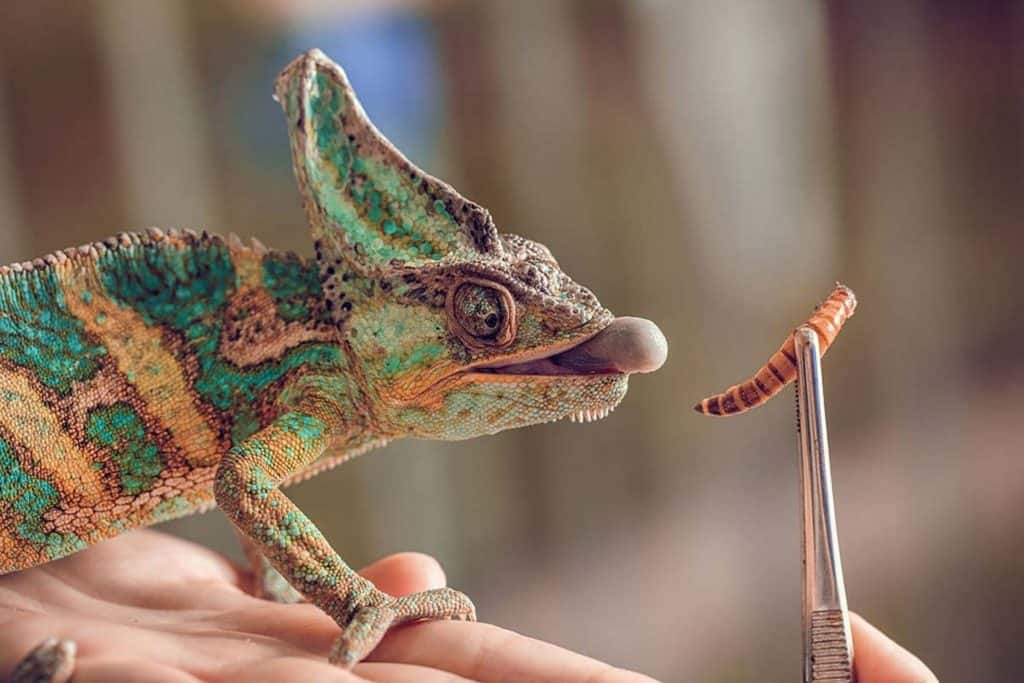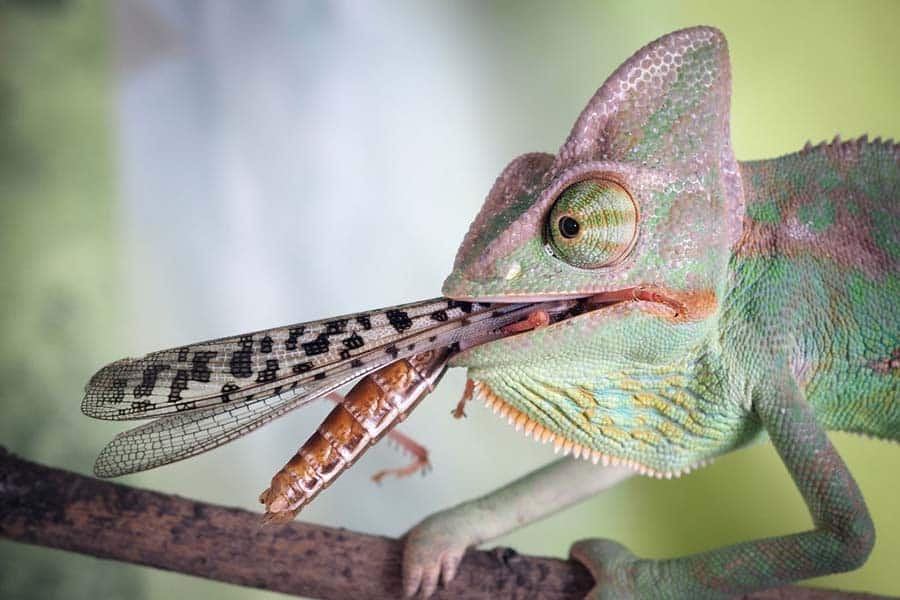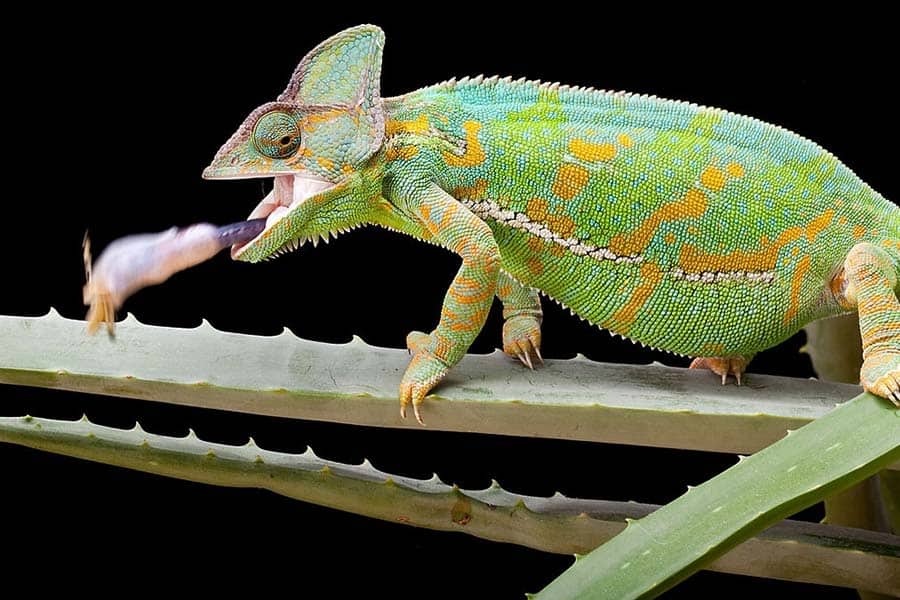
Chameleons are primarily insectivorous. This means they mainly eat insects, but that is not as boring as it sounds! They must have variety in their diet, or they may become bored and stop eating altogether!
What Do Chameleons Eat? Chameleons have fascinating dietary preferences. Their diet primarily consists of live insects, such as crickets, grasshoppers, and mealworms. Some chameleon species may also consume small birds, lizards, or even fruits and vegetation.
The chameleon’s tongue is a fascinating piece of equipment that is far more advanced than any knife and fork we have ever used. It’s also one of the reasons why these unique lizards are so popular among reptile enthusiasts.
Without further ado, let’s cover the basics of the chameleon’s diet, how they eat, and how you can keep yours healthy and happy.
How the Chameleon’s Tongue Works
Before understanding what your chameleon should eat, it helps to first understand how they eat. A chameleon’s tongue is absolutely fascinating! It is a bizarre piece of natural engineering that makes the chameleon such a popular pet because you can watch them eat for hours on end.
A chameleon’s tongue is very long and folded into the back of the mouth ready for action. At the end of their tongue, there is a very powerful ball of muscle.
When the chameleon launches its tongue at a prey item, this ball of muscle hits the item and immediately contracts, which creates an incredibly strong suction cup. This is why their tongues are called ‘sticky,’ because it appears as though the insect becomes stuck to the tongue.
The tongue is then wound back into the mouth and the chameleon chomps down on the insect with their strong jaws.
What Do Chameleons Eat? Their Staple Diet
Since they are insectivores, the staple diet for chameleons is insects–lots and lots of big, juicy, wriggly bugs! Here’s what you should know as far as the types of bugs you should be feeding your chameleon.
Feeder Insects
Chameleons eat all kinds of insects in the wild and should have access to the same kind of variety when they are kept as pets. There are many different kinds of feeder insects you can find at local pet shops or from online retailers, and they all have different nutritional values.

Staple feeder insects for a chameleon’s diet can include:
- Dubia roaches
- Crickets
- Locusts and grasshoppers
- Mantids
- Hornworms
- Black soldier fly larvae (also known as Phoenix worms)
- Blue and green bottle flies
- Silkworms
- Mealworms
- Slugs and snails
- Earthworms
Live feeders are readily available and can be bought from breeders, pet shops, or online distributors. Make sure you are getting them from a reputable source and that they are free from pesticides, insecticides, and parasites that will harm your chameleon. However, you can always raise your own live feeders!
Each feeder insect has its own nutritional value. It is important to note how much protein, fat, moisture, and
Gut Loading Feeder Insects
It is important to remember that, even if they only eat insects, chameleons still need nutrients that come from plant matter. This means that the insects you feed your chameleon need to be gut loaded, or fed nutritious veggies and fruits prior to being given to your lizard.
Around 12 to 24 hours before you feed your chameleon, you should gut load your feeder insects with nutrient rich veggies. Gut loading simply means feeding the insects nutritious fruits and veggies to make them more nutritious for your chameleon. The 12 to 24-hour time frame is important because it gives the feeder enough time to partially digest the food but not enough time to fully metabolize the nutrients.
Ideal foods to gut load your insects on include:
- Collard greens
- Kale
- Sweet potatoes
- Yellow squash
- Broccoli
- Berries
About Insect Size
Chameleons can handle bigger insects than many other lizards commonly kept as pets. However, their prey still needs to be appropriately sized. Feeder insects should not be larger than the width of your chameleon’s head. Chameleons come in many different sizes, so keep this in mind when choosing bugs to feed them.
Veiled chameleons, for example, are much smaller than Parson’s chameleons. This means veiled chameleons eat smaller prey items. For example, a veiled chameleon can be fed small-to-medium-sized crickets, whereas a Parson’s chameleon can be fed larger locusts and roaches.
If the insects you offer your chameleon are too large, then they can cause choking and digestive problems like impaction. In some cases, your chameleon may refuse to eat them at all.
Vitamin Supplements
Chameleons need
When you select the insects for your chameleon’s meal, there are a couple of ways you can dust them with
calcium powder. You can sprinkle the supplement over them, or you could put them in a plastic bag or container with some of the supplement in it and give it a gentle shake to coat the insects.
After dusting the insects thoroughly, you can feed your chameleon as usual with the knowledge that they have all the
Treat Items
Treats form an important part of your chameleon’s diet. They provide stimulation and excitement around feeding time. Be careful not to overdo it, though, because too many treat items can cause your chameleon to become obese.
Humans, dogs, and cats love treats, and so do chameleons! Chameleon treats look a little different to your late night chocolate snack, though. An ideal treat for a chameleon is a juicy, fatty worm!
Treat insects include:
- Morio worms
- Wax worms
- Butter worms
- Bamboo worms
The above insects are great treats for chameleons, but due to their high-fat content and low nutritional value otherwise, they shouldn’t be used as staple feeders.
For larger species of chameleons like the Parson’s chameleon, a once-a-month treat item can be a pinkie mouse. The pinkie must be very small and very young so its bones are still cartilaginous and soft enough to eat.
Other Potential Food Items
Some chameleons enjoy plant matter, but others don’t. As chameleons are mostly insectivores, they do not need plant matter because they get most of their essential nutrients from the insects that they eat.
To see if your chameleon likes plant matter, offer them pieces that are appropriately sized. If they seem to enjoy it, then you can include it in their diet. If they do not, don’t stress about it.
Be sure to research if the plant matter is safe for them to eat first; some foods, like avocado and rhubarb, are toxic to most reptiles.
Safe plant matter for chameleons include:
- Collard greens
- Dandelion greens
- Yellow and orange squash
- Berries
- Sweet melon
- Rocket
- Carrot
- Grapes
- Sugar snap peas
- Apple
Make sure all plant matter is washed carefully to remove any waxes and insecticides. You must also remove all stones, pips, and seeds prior to feeding.
Fruit is high in sugar and should be limited and treated the same as fatty worms, though it is a good occasional treat if your chameleon has a taste for it.
How to Feed Your Chameleon
There are a number of ways to feed your chameleon. All of the methods listed below are safe and work well depending on your pet’s preferences. Find what works for you and your chameleon, and stick to it.
Feeding by Hand
Feeding a chameleon by hand is exciting, and it gives you time to be close to your chameleon without having to directly handle them and risk stressing them out. Pick up the insects by hand or with a pair of feeding tongs and bring them about a hand’s distance to your chameleon.
Now, watch out for the best part! The chameleon will launch its awesome tongue out and catch the insect. Be careful not to jerk your hand away from your chameleon and startle them.
Let the Insects Loose
Take one insect at a time and place them in your chameleon’s enclosure. Keep track of what and how many insects you are putting in the enclosure, and avoid leaving uneaten insects behind after meal times. If your chameleon does not look interested in eating what remains, then you’ll need to remove them.
If you choose this option, stick to one plant, leaf cluster, or surface to put your feeder insects on so your chameleon gets used to where it will find food.

Placing Insects in a Container
Place the insects in a container that is not transparent. See-through or glass containers can confuse chameleons because they do not always see the glass, and they can hurt themselves by launching their tongues at the container instead of the insects.
Put the container at the bottom of the enclosure so your chameleon can look down on it and ‘hunt’ their food.
What About Water?
Unlike bearded dragons and some geckos, chameleons do not drink standing water. They do not recognize water in a dish as water at all! They only drink water from droplets on plants and surfaces within their enclosure.
There are two main ways you can offer your chameleon water to keep them properly hydrated.
- Misting/fogging system: A misting/fogging system will periodically release mist into your chameleon’s enclosure. The water vapor will collect on leaves and other surfaces for your chameleon to drink from. Because chameleons need to be in a screened enclosure, a misting system will help maintain healthy humidity levels.
- Dripping system: A dripping system (homemade or purchased) will let droplets of water land on a leaf or another surface periodically for your chameleon to drink from.
It is important to make sure the water in the dripping or misting/fogging system is clean and refreshed daily. The containers need to be cleaned thoroughly to avoid bacterial and slime buildup.
Additionally, using live plants in your chameleon’s enclosure will not only help with maintaining humidity levels but will also provide them with a surface to drink from. Live plants do not absorb water droplets before your pet can get to them like some synthetic plants do.
Help! My Chameleon Won’t Eat!
If you’ve noticed your chameleon refusing to eat, there are a few potential reasons for this behavior. Let’s explore each of them in detail to help you pinpoint the reason for your chameleon’s sudden hunger strike.
Dehydration
If your chameleon is dehydrated, then it is very unlikely they will have the energy to eat or even want to eat food. A dehydrated chameleon is easily recognizable. They have sunken eyes, yellow to orange urate, extra folds in their skin, and they are extra lethargic.
There are many simple ways to treat your dehydrated chameleon to get it back to full health. Check out our guide on caring for a dehydrated chameleon.
Improper/Excessive Handling
Your chameleon may not be eating because they are being handled too frequently or too roughly. Chameleons do not do well with handling in general, and they prefer to be left alone in their enclosure. They are active animals and do not need handling to provide stimulation and exercise.
If you are looking for a lizard that enjoys frequent handling, check out our guide on the best lizards for handling: species that welcome your touch.
Boredom
Chameleons need variety in their diet. They will get bored from eating the same feeder insects every day. In fact, they can become so bored that they will simply stop eating! Offer them variety in their diet in the form of various types of insects with unique textures, sizes, and flavors.
This does not mean you have to have a buffet of insects for your chameleon at every meal! You do not need to break the bank when finding new and exotic worms, but it is advisable to offer different feeder insects in a meal and change it up week to week.
For example, you could feed your chameleon two dubia roaches, two hornworms, and either two crickets or locusts at every meal.
Problems with Their Enclosure
If your chameleon isn’t eating, they may be experiencing stress from improper husbandry practices. If their enclosure is too cold or too hot, too humid or too dry, too light or too dark, there are not enough hiding places, too noisy, etc., they will experience high levels of stress and can go off of food.
Check all of your settings and equipment. Chameleons are known for being quite finicky when it comes to their enclosure setups, so make sure every part of their habitat is just right.
Parasites/Illness
If your chameleon is sick or has contracted parasites, they will not want to eat. Look out for signs of diarrhea, dehydration, and lethargy. If you suspect your chameleon is sick, then urgently get them to an exotic vet for further guidance and a detailed treatment plan.
FAQs Chameleon Diet
I have never kept a lizard before, and I do not like live bugs. What should I feed my chameleon?
Chameleons need live feeders. They are primarily insectivores, and they cannot subsist on a plant based diet or a powdered diet like many species of geckos.
Chameleons are also not recommended for first-time lizard owners, as they are quite picky and not very forgiving if you make any mistakes with their care needs.
Check out our guide on the best lizards for first-time lizard owners for a lizard that best suits your needs if a chameleon is too demanding and complex for you.
Can I feed my chameleon insects from around the house or the garden?
It is advisable that you do not feed your chameleon insects that you or they caught from around your house or from your garden. ‘Wild’ insects can be infected with parasites that can harm your chameleon. They may also be contaminated with insecticides or pesticides.
A Tongue-Tied Goodbye
Chameleons are fascinating lizards to own. While they are not the cuddly kind of pet that enjoys being handled, they make beautiful display animals and will provide you with endless hours of exciting and interesting behavior to watch.
As insectivores, chameleons eat a wide variety of insects; however, some individuals may also enjoy small amounts of fruits and vegetables in their diet. Feeding a chameleon is half the fun of owning one because of their unique tongues and style of catching prey.

